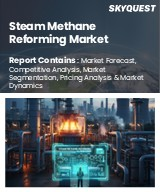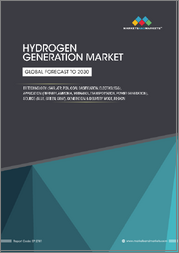
|
시장보고서
상품코드
1528963
세계의 BTH(Biogas to Hydrogen) 시장 규모 : 제조 공정별, 용도별 - 예측(2024-2032년)Biogas to Hydrogen Market Size - By Production Process (Steam Methane Reforming, Autothermal Reforming, Partial Oxidation Reforming), By Application (Power Generation, Chemicals, Marine, Transport) & Forecast, 2024 - 2032 |
||||||
BTH(Biogas to Hydrogen) 세계 시장은 주요 기업 간의 전략적 제휴에 힘입어 2024년부터 2032년까지 28%의 연평균 복합 성장률(CAGR)을 나타낼 것으로 전망됩니다.
이러한 파트너십은 재생 가능 에너지와 가스 변환 기술에 대한 전문 지식을 활용하여 바이오가스 공급원으로부터의 지속 가능한 수소 생산을 촉진하기 위한 것입니다. 양사는 자원과 혁신을 결합하여 생산 능력을 확장하고 바이오가스를 수소로 전환하는 효율을 향상시키는 것을 목표로 하고 있습니다. 수소는 교통, 산업 등 다양한 분야의 탈탄소화에 필수적인 청정 연료입니다.
예를 들어, 2024년 4월 인도바이오가스협회(IBA)는 인도수소협회(HAI)와 협력하여 바이오에너지 솔루션, 특히 그린 수소와 청색 수소를 촉진할 것이라고 IBA의 가우라브 케디아 회장은 PTI와의 인터뷰에서 말했습니다. 재생 가능 에너지 생산을 촉진하기 위한 양해각서를 체결했다고 밝혔습니다.
이러한 파트너십은 또한 새로운 기술 및 공정 연구를 촉진하고 비용을 낮추며 BTH(Biogas to Hydrogen) 솔루션의 실행 가능성을 높입니다. 전 세계가 탄소 배출을 줄이기 위한 노력을 강화하는 가운데, BTH(Biogas to Hydrogen) 전환 시장은 지속 가능한 미래를 위해 보다 친환경적인 에너지 솔루션을 개발하는 데 주력하는 강력한 업계 파트너십에 힘입어 크게 확대될 태세를 갖추고 있습니다.
자가열개질 분야는 2032년까지 양호한 성장률을 보일 것으로 예상됩니다. 자가 열 개질 공정은 유기물에서 추출한 바이오가스를 효율적이고 지속적으로 수소로 전환합니다. 자가열 개질은 단일 반응기에서 수증기 개질과 부분 산화를 결합하여 에너지 소비와 탄소 배출을 최소화하면서 수소 생산을 최적화합니다. 산업계와 정부가 청정 에너지 솔루션을 우선시하는 가운데, 자동 열 개질은 연료전지 및 산업 공정과 같은 다양한 용도의 수소를 생산할 수 있는 확장 가능한 방법을 제공합니다. 시장 성장의 원동력은 보다 친환경적인 에너지원으로의 전환을 지원하고 화석 연료에 대한 의존도를 낮출 수 있다는 점입니다.
산업계와 유틸리티가 더 깨끗한 에너지 솔루션을 찾고 있기 때문에 2024년부터 2032년까지 발전 분야가 BTH(Biogas to Hydrogen) 변환 시장의 용도를 지배할 것으로 보입니다. 유기 폐기물에서 추출한 바이오가스는 수증기 개질이나 전기분해와 같은 공정을 통해 수소로 전환됩니다. 청정 연료인 수소는 연료전지에서 수증기 외에는 아무것도 배출하지 않고도 전기를 생산할 수 있습니다. 이러한 능력은 BTH(Biogas to Hydrogen) 변환을 분산형 발전의 매력적인 대안으로 만들어 환경에 미치는 영향을 줄이면서 안정적인 전력을 공급할 수 있게 합니다. 전 세계 에너지 수요가 지속가능성을 향해 진화하는 가운데, BTH(Biogas to Hydrogen) 발전 시장은 재생 가능 에너지 기술의 혁신을 주도하며 성장할 준비가 되어 있습니다.
유럽에서는 야심찬 기후 목표와 재생 가능 에너지로의 전환을 배경으로 바이오가스에서 수소로 전환(BTH, Biogas to Hydrogen) 솔루션에 대한 수요가 증가하고 있습니다. 유기성 폐기물로 만든 바이오가스는 수증기 개질이나 전기분해와 같은 첨단 변환 기술을 통해 수소를 생산할 수 있는 잠재력이 있기 때문에 그 가치가 높아지고 있습니다. 이 수소는 유럽 전역의 산업, 운송 및 난방 부문의 탈탄소화에 있어 매우 중요합니다. 유럽 국가들은 지원 정책, 인프라 투자, 공동 연구 이니셔티브를 통해 BTH(Biogas to Hydrogen) 전환을 가속화하고 있으며, 유럽 대륙의 지속가능한 에너지 미래를 육성하고 탄소중립을 달성하고 에너지 안보를 강화하기 위해 노력하고 있습니다.
목차
제1장 조사 방법
- 조사 디자인
- 기본 추정과 계산
- 예측 모델
- 1차 조사와 검증
- 1차 정보
- 데이터 마이닝 소스
제2장 주요 요약
제3장 업계 인사이트
- 업계 에코시스템
- 규제 상황
- 업계에 대한 영향요인
- 성장 촉진요인
- 업계의 잠재적 리스크&과제
- 성장 가능성 분석
- Porter's Five Forces 분석
- PESTEL 분석
제4장 경쟁 구도
- 서론
- 전략적 전망
- 혁신과 지속가능성 전망
제5장 시장 규모와 예측 : 제조 공정별, 2021-2032년
- 주요 동향
- 증기 메탄 개질
- 오토 서멀 개질
- 부분 산화 개질
- 기타
제6장 시장 규모와 예측 : 용도별, 2021-2032년
- 주요 동향
- 발전
- 화학
- 해양
- 운송
- 기타
제7장 시장 규모와 예측 : 지역별, 2021-2032년
- 주요 동향
- 북미
- 유럽
- 아시아태평양
제8장 기업 개요
- Air Products and Chemicals, Inc.
- Alps Ecoscience
- Fortescue
- FuelCell Energy
- Hazer Group Limited
- H2B2
- H2 Energy Group
- Hyundai Motor Company
- Kiwa
- Kore
- Linde Plc
- Maire Tecnimont S.p.A.
- RGH2
- SYPOX GmbH
- Technip Energies N.V.
Global Biogas to Hydrogen Market will witness a 28% CAGR between 2024 and 2032 fueled by strategic partnerships between leading companies. These collaborations leverage expertise in renewable energy and gas conversion technologies to advance sustainable hydrogen production from biogas sources. By combining resources and innovation, companies aim to scale production capabilities and improve efficiency in converting biogas into hydrogen, a clean fuel crucial for decarbonizing various sectors like transportation and industry.
For instance, in April 2024, the Indian Biogas Association (IBA) collaborated with the Hydrogen Association of India (HAI) to advance bio-based energy solutions, particularly focusing on green and blue hydrogen. In an interview with PTI, Gaurav Kedia, Chairman of IBA, stated that the two organizations have signed a memorandum of understanding (MoU) aimed at fostering the production of renewable energy within India.
These partnerships also facilitate research into new technologies and processes, driving down costs and enhancing the viability of biogas-to-hydrogen solutions. As global commitments to reduce carbon emissions intensify, the market for biogas to hydrogen is poised for significant expansion, supported by robust industry alliances focused on pioneering greener energy solutions for a sustainable future.
The overall Biogas to Hydrogen Industry size is classified based on the production process, application, and region.
The autothermal reforming segment will exhibit a decent growth rate through 2032. Autothermal reforming process converts biogas, derived from organic materials, into hydrogen efficiently and sustainably. Autothermal reforming combines steam reforming with partial oxidation in a single reactor, optimizing hydrogen production while minimizing energy consumption and carbon emissions. As industries and governments prioritize clean energy solutions, autothermal reforming offers a scalable method to produce hydrogen for various applications, including fuel cells and industrial processes. The market's growth is driven by its potential to support a transition towards greener energy sources and reduce dependence on fossil fuels.
The power generation segment could dominate the application landscape of the Biogas to Hydrogen market over 2024-2032 as industries and utilities seek cleaner energy solutions. Biogas, derived from organic waste, is converted into hydrogen through processes like steam reforming or electrolysis. Hydrogen, a clean fuel, can then be used in fuel cells to generate electricity with zero emissions other than water vapor. This capability makes biogas-to-hydrogen an attractive option for decentralized power generation, providing reliable electricity while reducing environmental impact. As global energy demands evolve towards sustainability, the market for biogas to hydrogen for power generation is poised for growth, driving innovation in renewable energy technologies.
In Europe, there is a growing demand for biogas to hydrogen solutions driven by ambitious climate targets and a shift towards renewable energy. Biogas, sourced from organic waste, is increasingly valued for its potential to produce hydrogen through advanced conversion technologies like steam reforming and electrolysis. This hydrogen is pivotal in decarbonizing industries, transportation, and heating sectors across Europe. With supportive policies, investments in infrastructure, and collaborative research initiatives, European countries are accelerating the adoption of biogas to hydrogen, aiming to achieve carbon neutrality and enhance energy security while fostering a sustainable energy future for the continent.
Table of Contents
Chapter 1 Research Methodology
- 1.1 Research design
- 1.2 Base estimates & calculations
- 1.3 Forecast model
- 1.4 Primary research & validation
- 1.4.1 Primary sources
- 1.4.2 Data mining sources
Chapter 2 Executive summary
- 2.1 Industry 360° synopsis, 2019 - 2032
Chapter 3 Industry Insights
- 3.1 Industry ecosystem
- 3.2 Regulatory landscape
- 3.3 Industry impact forces
- 3.3.1 Growth drivers
- 3.3.2 Industry pitfalls & challenges
- 3.4 Growth potential analysis
- 3.5 Porter's analysis
- 3.5.1 Bargaining power of suppliers
- 3.5.2 Bargaining power of buyers
- 3.5.3 Threat of new entrants
- 3.5.4 Threat of substitutes
- 3.6 PESTEL analysis
Chapter 4 Competitive landscape, 2023
- 4.1 Introduction
- 4.2 Strategic outlook
- 4.3 Innovation & sustainability landscape
Chapter 5 Market Size and Forecast, By Production Process, 2021 - 2032 (MT & USD Million)
- 5.1 Key trends
- 5.2 Steam methane reforming
- 5.3 Autothermal reforming
- 5.4 Partial oxidation reforming
- 5.5 Others
Chapter 6 Market Size and Forecast, By Application, 2021 - 2032 (MT & USD Million)
- 6.1 Key trends
- 6.2 Power generation
- 6.3 Chemicals
- 6.4 Marine
- 6.5 Transport
- 6.6 Others
Chapter 7 Market Size and Forecast, By Region, 2021 - 2032 (MT & USD Million)
- 7.1 Key trends
- 7.2 North America
- 7.3 Europe
- 7.4 Asia Pacific
Chapter 8 Company Profiles
- 8.1 Air Products and Chemicals, Inc.
- 8.2 Alps Ecoscience
- 8.3 Fortescue
- 8.4 FuelCell Energy
- 8.5 Hazer Group Limited
- 8.6 H2B2
- 8.7 H2 Energy Group
- 8.8 Hyundai Motor Company
- 8.9 Kiwa
- 8.10 Kore
- 8.11 Linde Plc
- 8.12 Maire Tecnimont S.p.A.
- 8.13 RGH2
- 8.14 SYPOX GmbH
- 8.15 Technip Energies N.V.



















